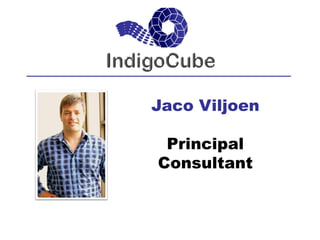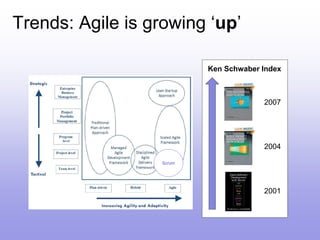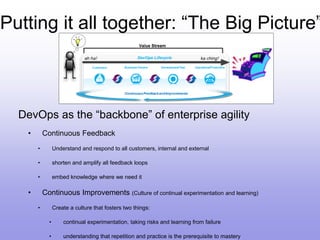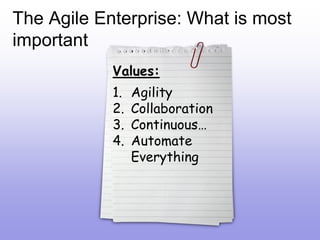IndigoCube the agile enterprise: moving beyond scrum by JacoViljoen
- 4. Problems/Challenges Now that we solved these problems, what’s next?
- 5. Problems/Challenges • Binary Thinking • Project-level paradigm • Management and Governance • The bottleneck (IT Ops) How does the world go about solving these? What are the themes or trends? "7th ANNUAL STATE of AGILE DEVELOPMENT SURVEY" - VERSIONONE® 2012
- 6. Trends • Dominance of Scrum • Agile is growing “up” • Emergence of “Lean” • DevOps: The New Kid on the Block • Marriage of Agile, Lean and DevOps
- 7. “2 dimensional grid depicting enterprise agile frameworks" - Charles Cobb 2013 Trends: Dominance of Scrum Scrum "7th ANNUAL STATE of AGILE DEVELOPMENT SURVEY" - VERSIONONE® 2012
- 8. 2001 2004 2007 Ken Schwaber Index Trends: Agile is growing ‘up’ Scrum
- 9. Trends: Emergence of Lean and Kanban • Focus on the end-to-end value stream • Different way to look at flow of work • Lean looks at “delays” • Kanban looks for “bottlenecks” Kanban is principally about making work flow visible. It revolves around a visual board for managing work in progress and making flow—constraints to flow—visible.
- 10. Trends: DevOps, the New Kid on the Block • Generation 1: Operations use development tools • Generation 2: Get developers and operations to collaborate • Generation 3: Scale up to whole organisation
- 11. • Agile, Lean and DevOps are complementary • Agile Reaches Ops (“Small DevOps”) • Agile & Lean applied to the whole software delivery chain, not just developers (“Big DevOps”) • Should have been “BizDevQaSecReleaseOps” Family name is “DevOps” Trends: Marriage of Agile, Lean and DevOps
- 13. Putting it all together: “The Big Picture” DevOps as the “backbone” of enterprise agility • Emphasise the performance or agility of the entire system • “Concept to Cash” • Value stream: Include customers, business owners, development/test and operations/production) • Collaboration; breaking down barriers • Continuous flow of work • Minimise delays • Manage work in progress (bottlenecks)
- 14. Putting it all together: “The Big Picture” DevOps as the “backbone” of enterprise agility • Continuous Feedback • Understand and respond to all customers, internal and external • shorten and amplify all feedback loops • embed knowledge where we need it • Continuous Improvements (Culture of continual experimentation and learning) • Create a culture that fosters two things: • continual experimentation, taking risks and learning from failure • understanding that repetition and practice is the prerequisite to mastery
- 16. The Agile Enterprise: What is most important Values: 1. Agility 2. Collaboration 3. Continuous… 4. Automate Everything
- 17. 1. Agility • “A”gile vs. “a”gility • Pragmatism • Agile fit in the enterprise Scrum
- 18. Scaled Agile Framework (SAFe) • Developed by Dean Leffingwell • Enterprise-level agile framework • Goal: “Sustainable Shortest Lead Time” • Builds on: • Lean • Principles of Product development Flow • Agile (Scrum and XP) • DevOps (small) • Two knowledge bases: 1. SAFe 2. Implementing SAFe http://scaledagileframework.com/
- 19. Implementing SAFe • Can co-exist with Waterfall • Implementation Guidance • Training and Certification
- 20. 2. Collaboration: Breaking Down Walls Is your organisation like this?
- 21. 2. Collaboration: Breaking Down Walls "Agile was instrumental in development regaining the trust in the business, but it unintentionally left IT operations behind. DevOps is a way for the business to regain trust in the entire IT organization as a whole.“ - Clyde Logue, founder of StreamStep
- 22. 3. Continuous … • Continuous Business Planning • Continuous Build and Delivery Pipeline • Continuous Integration • Continuous Testing • Continuous Delivery • Continuous Monitoring • Continuous Feedback and Improvements What about projects?
- 23. 3. Continuous … Is your organisation like this? What about projects?
- 24. 3. Continuous … Two paradigms: 1. PMO view work as continues flow (a.k.a. pipeline) 2. PMO view work as projects (work flow within batch) What about projects?
- 25. 4. Automate Everything • Embed knowledge/learnings using automation/tools • The best way to change culture is to change the tools
- 27. Entry Points into the Agile Enterprise
- 30. 30
- 31. Managed Agile Development Framework • Developed by Charles Cobb • Hybrid project-level framework • Plan-driven approach layered on top of an Agile development process • Typically merge PMI/Prince 2 with Scrum
- 32. Disciplined Agile Delivery Framework (DAD) • Developed by Scott Ambler • A project-level framework
- 33. Lean Startup Approach • Developed by Eric Ries • A startup • is a human institution designed to deliver a new product or service under conditions of extreme uncertainty • Startup = Experiment • Principles • Entrepreneurship is management • Validated Learning • Innovation Accounting BUILD-MEASURE-LEARN FEEDBACK LOOP

































